Creating a Geo-Referenced Terrain
To create a terrain based on the real world geodata, perform the steps described in the chapters below.
See Also
- Create a Terrain article if you need to:
- Create a terrain based on ordinary images only (with no geo referencing).
- Create a terrain based on both the sources with no geodata and the geo-referenced ones.
1. Specifying Data Sources#
The data sources should be specified before proceeding.
 dedicated video tutorial.
dedicated video tutorial.All geo-referenced data sources are divided into five types (layers):
- Height (Elevation) (optional) - this type of data is used to generate terrain geometry.
- Albedo (Imagery) - this type of data is used to generate textures for the terrain surface.
- Masks (Landcover) (optional) - this type of data is used to generate natural features of the landscape (details, grass, trees, etc.).
- Vector (optional) - this type of data is used to generate roads, communications, buildings, landmarks, etc.
- Procedural (optional) - this type of data is used for procedural refinement.
To add a new source, click the Add Source button.
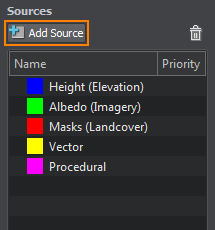
In the opened window, specify the following fields:
| Layer | The imagery, elevation, landcover, vector or procedural layer of the data source. |
|---|---|
| Name | The name of the layer that will be displayed in the Sources panel. |
| Path | The path to the data source file or folder. For geo-referenced terrain generation, the sources with no geodata can be used along with the geo-referenced ones. So, there are the following options:
Notice
Do not store the data source files in the data folder of the project as it will cause the following issues:
|
When you add the imagery, elevation, landcover, vector or procedural data sources to the Landscape tool, their areas will be highlighted on the Preview panel with corresponding colors: blue for elevation, green for imagery, red for landcover, yellow for vector and magenta for procedural. Area size of procedural sources is adjustable.
To delete the selected data source, press  or right-click the source and choose Delete in the drop-down list.
or right-click the source and choose Delete in the drop-down list.
You can create groups of data sources for each data layer, just right-click on a layer and select Add New Group. Thus, you can improve the structure of your data and manage all group members at once (enable/disable, add tags, modify parameters, etc.)
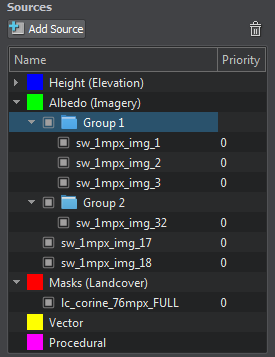
2. Specifying Data Source Parameters#
When you select a data source, you can see its parameters in the Parameters panel. Depending on the type of the data source, the contents of this panel differs.
Elevation Parameters#
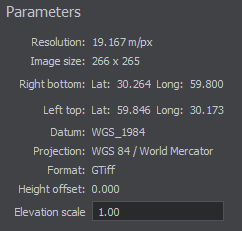
For the geo-referenced data source, you can specify the following parameter:
| Elevation scale | The scale factor used for elevation data. |
|---|
The parameters of the sources with no geodata are described here.
Imagery Parameters#
For the geo-referenced data source, you can specify the following parameter:
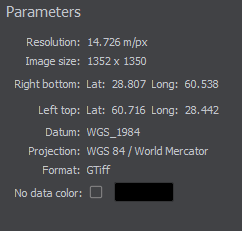
| No data color | The color to be used for areas with no data available. |
|---|
The parameters of the sources with no geodata are described here.
Landcover Parameters#
Landcover geodata/no geodata source parameters are described here. This type of data source is optional and should be added when generation of terrain details or vegetation is needed. It allows specifying both the geo-referenced and non-georeferenced sources.
Vector Parameters#
Vector geodata source parameters are described here. This type of data source is optional and should be added when generation of roads, communications, buildings, landmarks, etc. is needed. It allows specifying only the geo-referenced sources.
Procedural Parameters#
Procedural geodata source parameters are described here. This type of data source is optional and should be added when it is necessary to refine data from elevation, landcover or other procedural data sources.
3. Setting Up Natural Layer#
At this step you can check out the parameters of Terrain LODs to be generated for all data layers (elevation, imagery, normal, and detail masks) and determine the natural features of the landscape.
LOD Settings#
To access LOD settings of the particular data layer of your terrain, select the data source group in the list: all available settings will be displayed on the Parameters panel.

The Landscape Tool sets the number of LODs, their visibility distances and densities automatically. You can change these settings when necessary. To modify LOD settings for the desired data layer you should set Manual mode by checking the corresponding option located just under the list of LODs (see the picture below).
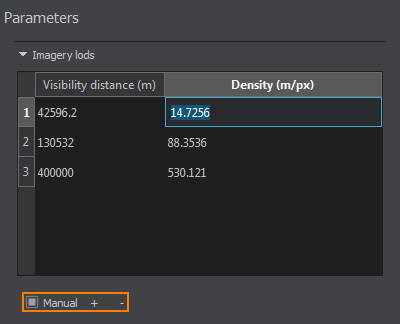
In the manual mode you can modify density and visibility distance values by simply double-clicking on the corresponding cell and entering the desired value. Use + (plus) button to add a LOD, or - (minus) to remove one.
Natural Features#
You can also determine, which natural features of the landscape are to be generated: select the Masks (Landcover) data source type and get access to the following settings on the Parameters panel:
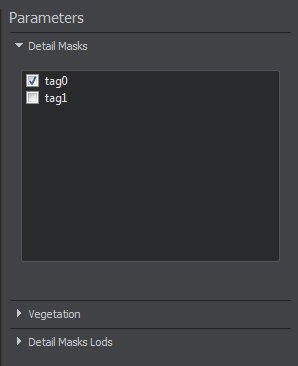
-
Terrain detail masks - the tags specified for landcover data sources that determine the areas for terrain details to be placed.
Workflow: Generating Detail Masks.
-
Vegetation (grass, trees, etc.) - Grass, Mesh Clutter, and World Clutter objects will be generated and placed in certain areas of the terrain according to specified landcover tags.
Workflow: Generating Vegetation.
4. Setting Up Cultural Layer#
At this step you can determine which cultural features of the landscape are to be generated: roads, communications, fences, pipes, buildings, landmarks, etc.
To get access to cultural features, select the Vector data source type and specify required settings on the Parameters tab. Objects of the cultural layer are divided into 4 groups depending on the type of vector data used for their generation:
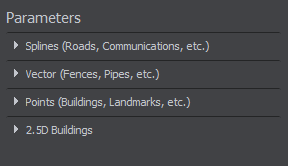
-
Spline (Roads, Communications, etc.) - objects of this type are stretched or tiled along Bezier splines.
Workflow: Generating Spline Objects.
-
Vector (Fences, Pipes, etc.) - objects of this type are generated and placed along vectors.
Workflow: Generating Vector Objects.
-
Point (Buildings, Landmarks, etc.) - objects of this type are generated and placed at certain points.
Workflow: Generating Point Objects.
2.5D Buildings - objects of this type are generated on the basis of Open Street Maps (OSM).
Workflow: Generating Buildings.
5. Specifying Settings#
Landscape tool generates a terrain according to the specified settings. Set the following parameters before starting terrain generation:
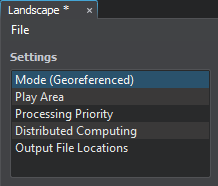
Modes and Projections#
To specify the terrain generation mode, select Mode in the list of Settings and choose the required mode on the Parameters panel:
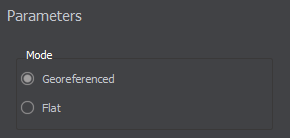
- Georeferenced - the terrain is based on the geodata sources. This mode should be set for geo-referenced terrain generation, even if the geodata sources are used along with the sources with no geodata.
- Flat - the terrain is based on the raster images with no geodata. If enabled, the capability to load the geo-referenced data sources is disabled.
NoticeThe Flat mode can be useful when you need to generate the terrain based only on raster images with no geodata in the Sim version of UNIGINE SDK.
In the Georeferenced mode, the following types of output projections (in the Preview map, the Play Area's projection) are available:

- Built-In (Geodetic Pivot) projection based on WGS-84 ellipsoid.
- Custom projection that is used for data with a custom source projection (not WGS-84 ellipsoid-based) saved by using a 3rd party software (e.g., CityEngine). Such projection should be described in the WKT (Well Known Text) format stored in .prj files (e.g., it can be generated in Global Mapper).
NoticeThe terrain generated with the custom projections cannot be curved.
In the Flat mode, no reprojection is performed. If for some reasons, you haven't specified this mode and have loaded only the sources with no geodata, reprojection won't be performed anyway.
Play Area#
Play Area is a rectangular area of a landscape to be generated.
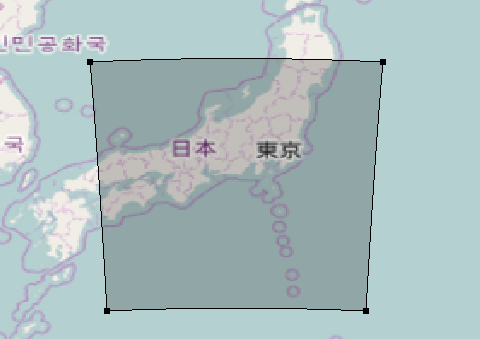
Play Area represents a gray outlined rectangular area in the Preview panel. Depending on the type of the output projection, it can look like a trapezium near the terrestrial poles due to the equirectangular projection, or it can be rectangular (if the Flat mode is set).
Click on the Play Area settings. In the Parameters panel the available parameters for Play Area will appear:

You can specify the following parameters:
| Center | Play Area's central point coordinates. |
|---|---|
| Size (km) | The size of the Play Area: width x height |
| Max visibility distance (km) | The maximum visibility distance of the Play Area in kilometres. |
Processing Priority#
Here you can specify the order in which data sources will be processed. For details, check the Create a Terrain article.
Distributed Computing#
Here you can set up distributed computing to be used for terrain generation. For details, check the Distributed Computing article.
Output File Locations#
Here you can specify the output path for your terrain data and cache parameters. When the Landscape tool faces a large amount of source data, it automatically cuts the data to small tiles and uses them as cache. The cache is used to speed up subsequent terrain re-generation.
- Landscape tool doesn't clear the cache automatically, you should do it manually if necessary.
- When clearing the cache remember, that next terrain re-generation will require more time.
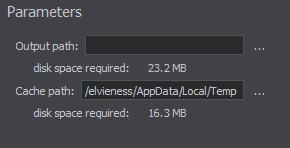
| Output path | Output path for generated terrain files. By default, a new folder in your project's data folder will be created. |
|---|---|
| Cache path | Path to cache files. |
Generating a Terrain#
The Landscape Tool stores the paths to all data sources as well as all generation parameters in an asset. So, after setting up all these parameters, you should save them by choosing File -> Save Asset and specifying the name and path for your asset.
Now you can generate the terrain by clicking the Generate button.
In the Generation Steps window, that appears, you can select what is to be generated.
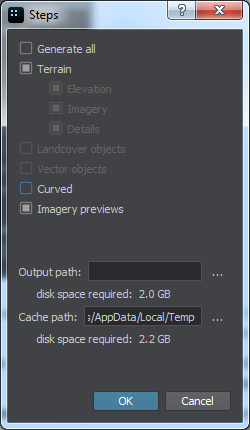
| Generate all | The whole terrain with detail masks, landcover objects and vector objects (spline, vector, and point) will be generated. This option is selected by default. |
|---|---|
| Terrain | Only terrain will be generated. Here you can select parts of terrain data used for generation (Elevation, Imagery, Details) |
| Landcover objects | Only landcover objects will be generated. |
| Vector objects | Only vector objects will be generated. |
| Curved | The flag indicating if the generated terrain should be curved (WGS-84 ellipsoid datum).
Notice
Landscape tool uses WGS-84 ellipsoid by default. After terrain generation, you can specify the Geodetic Pivot object's settings and choose another ellipsoid reference (including custom). |
| Imagery previews | The flag indicating if imagery previews are to be generated and placed at the corresponding location on the map displayed on the Preview panel. Thus, you can mark areas of the global map for which the terrain was generated. |
Also you can specify or change the output path for your terrain data and cache parameters.
If you have any unsaved changes, then after clicking OK in the Generation Steps window, you will see the window for saving the asset. Specify the name and the path for your asset and click Save.
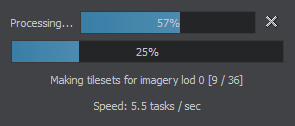
The generation status window will appear.

After successful generation process, the Landscape tool may offer your world settings optimizations. We recommend you to apply them, however, you can ignore.
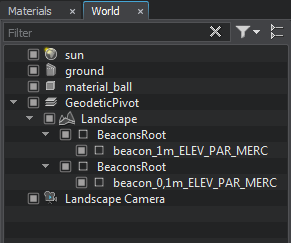
If you open the Nodes window, you can see that the Landscape tool created the following instances:
- The landscape_geodetic_pivot Geodetic Pivot object for curving the terrain according to WGS-84 ellipsoid.NoticeThis object will be generated regardless of whether the Curved option is selected in the Generation Steps window or not.
- TerrainGlobal Landscape object.
- Beacons - NodeDummy objects generated for all elevation sources in the Play Area. These beacons can be used to quickly move to certain terrain location.
- The Landscape Camera camera object which is placed in the center point of the terrain with specified all the necessary parameters (far and near clipping planes).